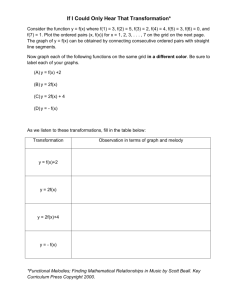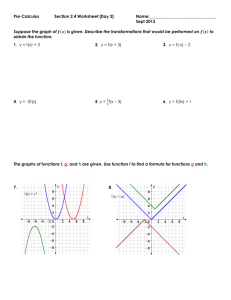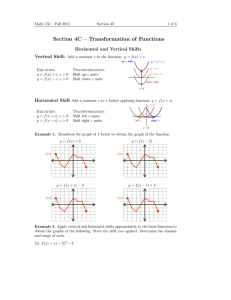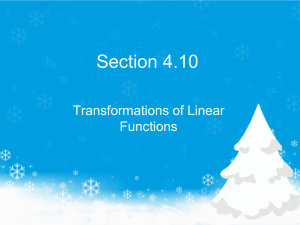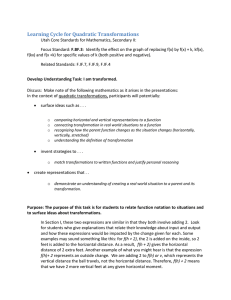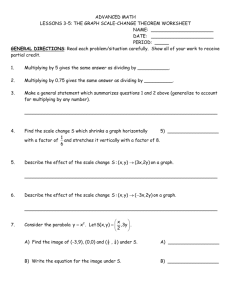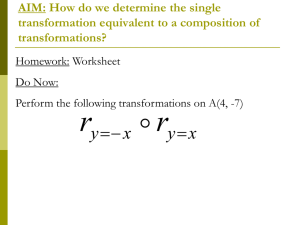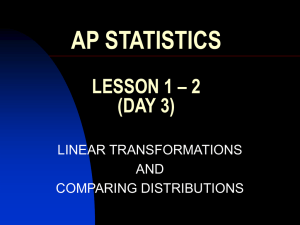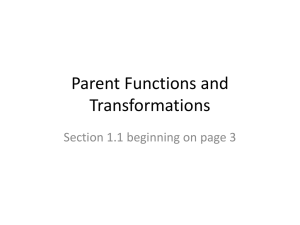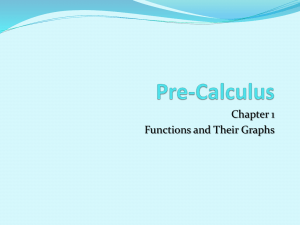Reflecting Graphs
advertisement
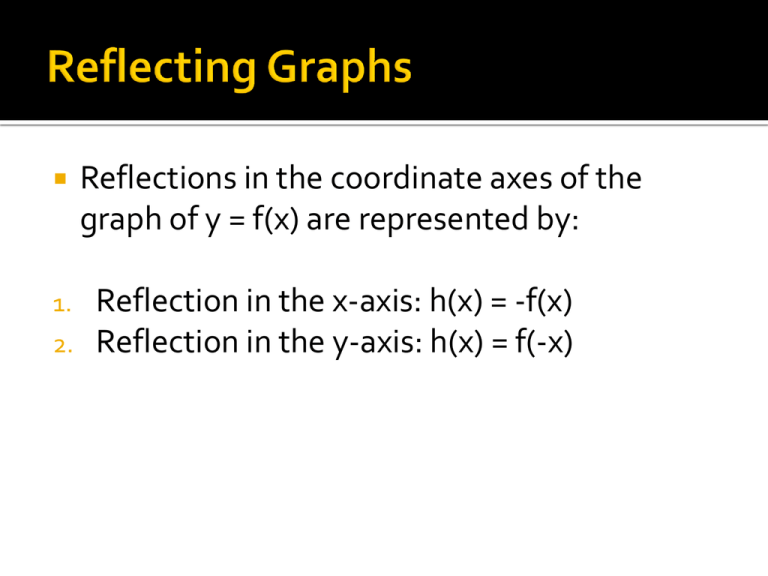
1. 2. Reflections in the coordinate axes of the graph of y = f(x) are represented by: Reflection in the x-axis: h(x) = -f(x) Reflection in the y-axis: h(x) = f(-x) g is related to one of the parent functions. Identify the parent function, describe the sequence of transformation from f to g. 1. 𝑔 𝑥 = 2 − 𝑥 + 5 2 1 − 4 𝑥+2 2−2 3. 𝑔 𝑥 = 𝑥 + 3 + 9 1 4. 𝑔 𝑥 = − 𝑥+3−1 2 5. 𝑔 𝑥 = − 𝑥 + 10 2 + 5 2. 𝑔 𝑥 = Use a graphing utility to graph the three functions in the same viewing window. Describe the graphs of g and h relative the graph of f. 1. 𝑓 𝑥 = 𝑥 3 − 3𝑥 2 2. 𝑔 𝑥 = 1 − 𝑓(𝑥) 3 3. ℎ 𝑥 = 𝑓(−𝑥) Compare the graph of each function with the graph of f(x) = 𝑥 alegebraically 1. 𝑔 𝑥 = − 𝑥 2. ℎ 𝑥 = −𝑥 3. 𝑘 𝑥 = − 𝑥 + 2 Horizontal, vertical, and reflection shifts are all call rigid transformations. These transformations only change the position of the graph in the coordinate plane Non-rigid transformations are those that cause distortion of the graph. A non-rigid transformation of the graph y= f(x) is represented by y = cf(x), where the transformation is a vertical stretch if c > 1 and a vertical shrink if 0 < c< 1. Another non-rigid transformation of the graph y = f(x) is represented by h(x) = f(cx), where the transformation is a horizontal shrink if c > 1 and a horizontal stretch if 0<c<1 𝑓 𝑥 = 𝑥 ℎ 𝑥 =3𝑥 1 𝑔 𝑥 = 𝑥 3 Write a few sentences comparing the graphs shown above. You may form into groups of 2-3 to complete the following quiz. Each member of your group must show all work in order to receive credit. After you have finished quiz, please be sure to answer the short answer question(on your own paper) Given the three following functions: 𝑓 𝑥 = 𝑥 3 − 3𝑥 2 + 2 𝑔 𝑥 = −𝑓 𝑥 ℎ 𝑥 = 𝑓(2𝑥) 1. Identify the parent function of f. 2. Describe the graphs of g and h relative to the graph of f. Justify your answer by sketching the graphs of each functions. Label the graph appropriatly. Just as real numbers can be combined by the operations of addition, subtraction, multiplication, and division to form other real numbers, two functions can be combined to create a new function. This is known as an arithmetic combination of functions. The domain of an arithmetic combination of functions f and g consists of all real numbers that are common to the domains of f and g. State the domain of the following combination: 𝑓 𝑥 𝑔(𝑥) Sum: f + 𝑔 (𝑥) = 𝑓 𝑥 + 𝑓 𝑔 Difference: 𝑓 − 𝑔 (𝑥) = 𝑓 𝑥 − 𝑔 𝑥 Product: 𝑓𝑔 𝑥 = 𝑓 𝑥 𝑔 𝑥 Quotient: 𝑓 𝑔 𝑥 = 𝑓 𝑥 , 𝑔(𝑥) 𝑔(𝑥) ≠0 Given the two functions find (f + g)(x): 𝑓 𝑥 = 2𝑥 + 1 𝑔 𝑥 = 𝑥 2 + 2𝑥 − 1 Given: 𝑓 𝑥 = 2𝑥 + 1 𝑔 𝑥 = 𝑥 2 + 2𝑥 − 1 Evaluate the difference of the two functions. Then evaluate the difference when x = 2 Given: 𝑓 𝑥 = 𝑥2 𝑔 𝑥 =𝑥−3 Find the product of the two functions then evaluate the product when x = 4. Given 𝑓 𝑥 = 𝑥 𝑔 𝑥 = 4 − 𝑥2 Find the quotient of the functions 𝑓 𝑔 𝑥 𝑎𝑛𝑑 function. 𝑔 𝑓 𝑥 . Find the domain of each Pg. 58 # 5 – 26
